
There’s a lot riding on this year’s vegetable garden. Not only is it meant to produce a certain amount of fresh and healthy food for the family, it’s also supposed to serve as an opportunity to gain valuable skills and experience.
So far, it looks like there’ll be a lot more learning than eating.
It’s been unusually wetter this June than in previous years. As far as I remember, the rains come in April and early May and by June it’s warm and sunny.
So, I’m not sure if all the rain is having a negative effect on my garden.
Fortunately, we’re not having any unexpected frosts, so it’s not all bad. And the plants are quite green.
Rough plan
Prior to even doing anything outside, I thought it might be a good idea to draw up a rough garden layout for this season. I’ve got three raised garden beds to work with and based on that I doodled the plan you see below.
As you can see, the far left bed is for for green beans and potatoes, the middle bed is for cherry tomatoes, garlic, daikon, kale and jalapeno peppers, and the one on the far right is for cucumbers, zucchini, bell peppers, carrots, radish and green peas.
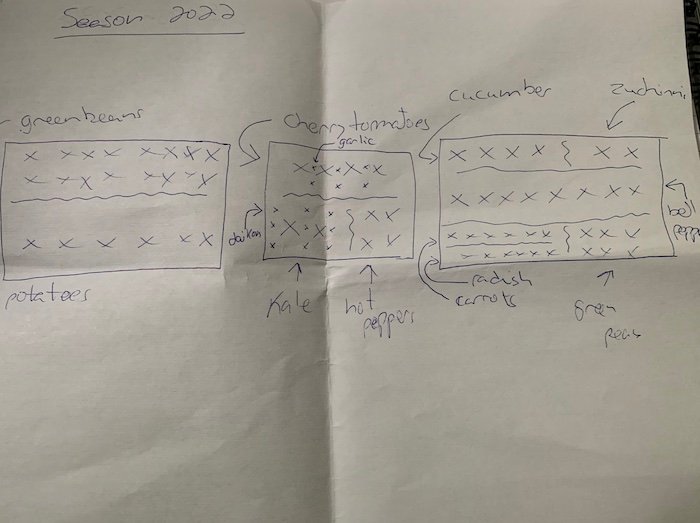
I planned the garden out this way after doing some internet research on companion planting. I wanted to make sure I didn’t put anything together that would kill each other.
The info from the ‘interwebs’ also seemed to jive with The Backyard Homestead – a book I’m using as a beginner’s guide as I embark on this food growing journey.
Radishes are the first to pop up
In early May, I planted radishes, green peas and carrots. The first plants to push out were the radishes. It’s somewhat silly, but I was really excited to see that little green line.

They popped up so fast that I might plant more in September. Maybe I can freeze or pickle them and then have some to eat during the winter.
More followed within weeks
By the end of May, the green peas, carrots, daikon and yellow zucchini were up, and the bell peppers, (Japanese) cucumbers, cherry tomatoes, jalapeno peppers too.
The potatoes, garlic, and green beans had also pushed out of the dirt and were growing nicely.
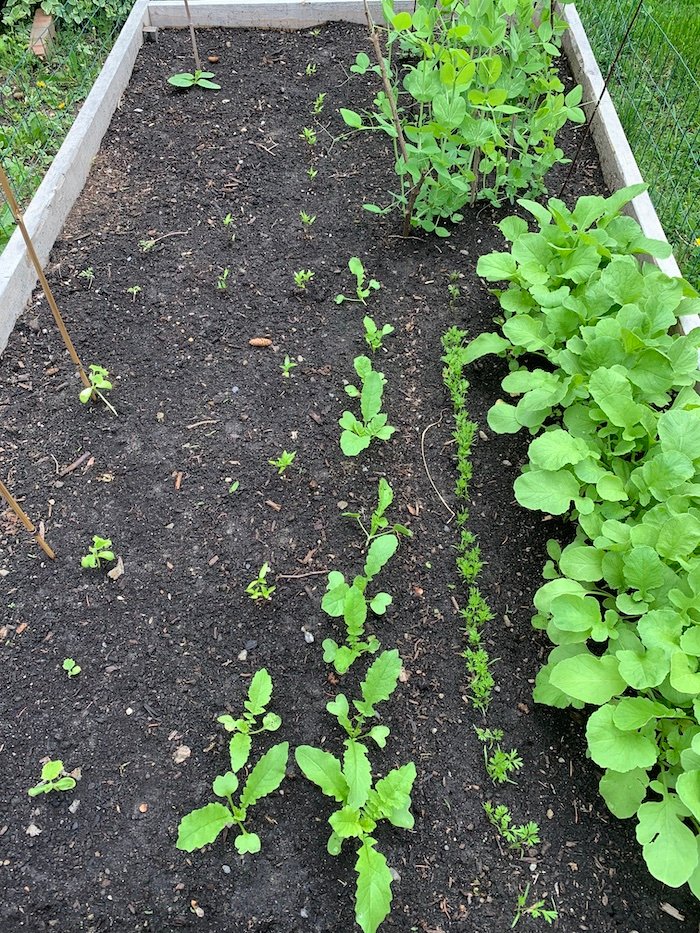 Radishes, carrots, peas, bell peppers, Japanese cucumbers, yellow zucchini
Radishes, carrots, peas, bell peppers, Japanese cucumbers, yellow zucchini
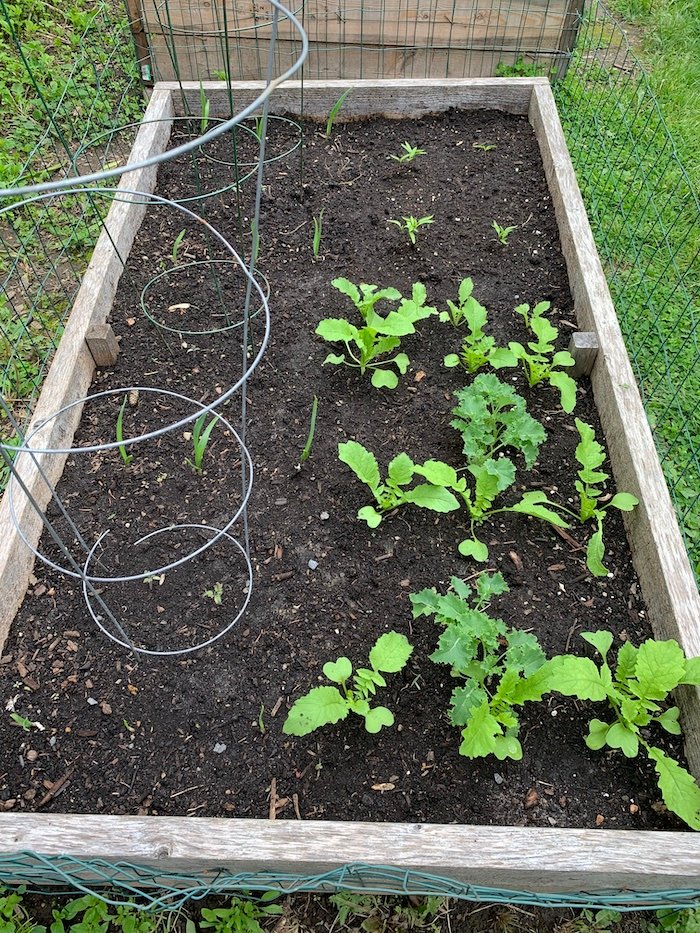 Daikon, kale, garlic, cherry tomatoes, jalapeno peppers
Daikon, kale, garlic, cherry tomatoes, jalapeno peppers
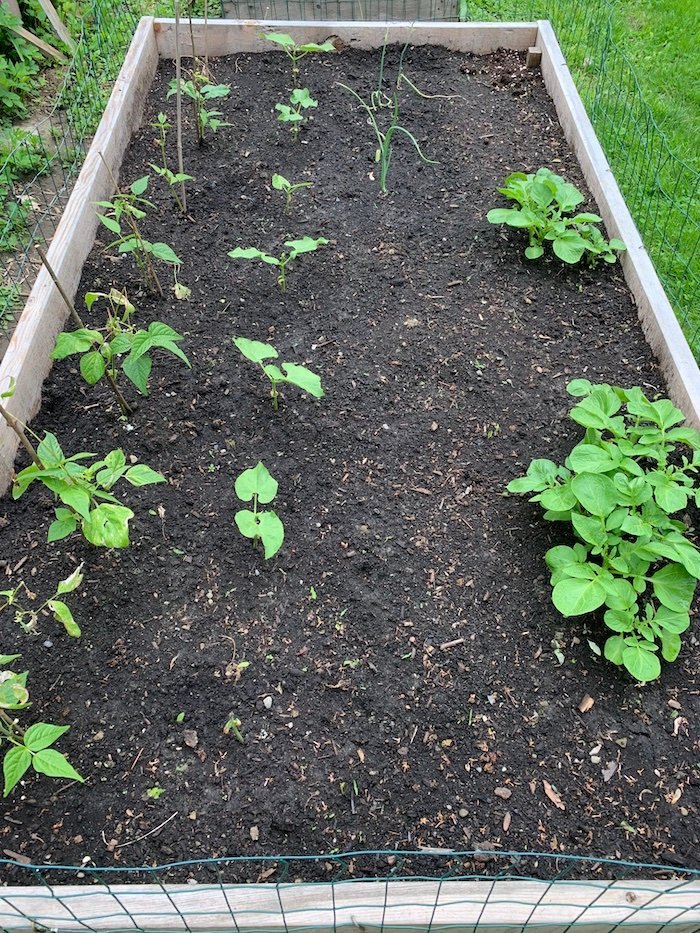 Potatoes, green beans, white onions
Potatoes, green beans, white onions
If you compare the pictures to the plan I originally drafted (up above) you’ll see that things aren’t exactly are planned in the far left and far right raised garden beds. There’s a couple of reasons for that.
1 – Earlier in the spring, I decided to try regrowing a single store bought white onion. It worked but to my surprise instead of one bulb the plant started to split into 4 bulbs.
I then decided to transplant them all to the garden – between the potatoes and the green beans – and so far so good. Except for that one that didn’t survive.
2 – I wasn’t sure about the daikon. I didn’t know if the seeds would sprout. And I had no one around me with experience growing them so I put a number of seeds in each hole.
They all sprouted!
Once more I got all excited and because I didn’t want to kill any I chose to leave only one daikon per hole and so I carefully plucked out the extra daikons and relocated them elsewhere (in the far right garden bed).
And that’s why I didn’t follow the plan.
Something to eat
Since the radishes were the first to come up, it makes sense that they’re the first crop ready to harvest. Right? And that’s what I’ve done but, interestingly enough, they’re not all growing at the same speed.
They all have a delicious pungent, sweet and peppery taste but the radishes vary in size. In fact, to this day, some are still not ready to pick.
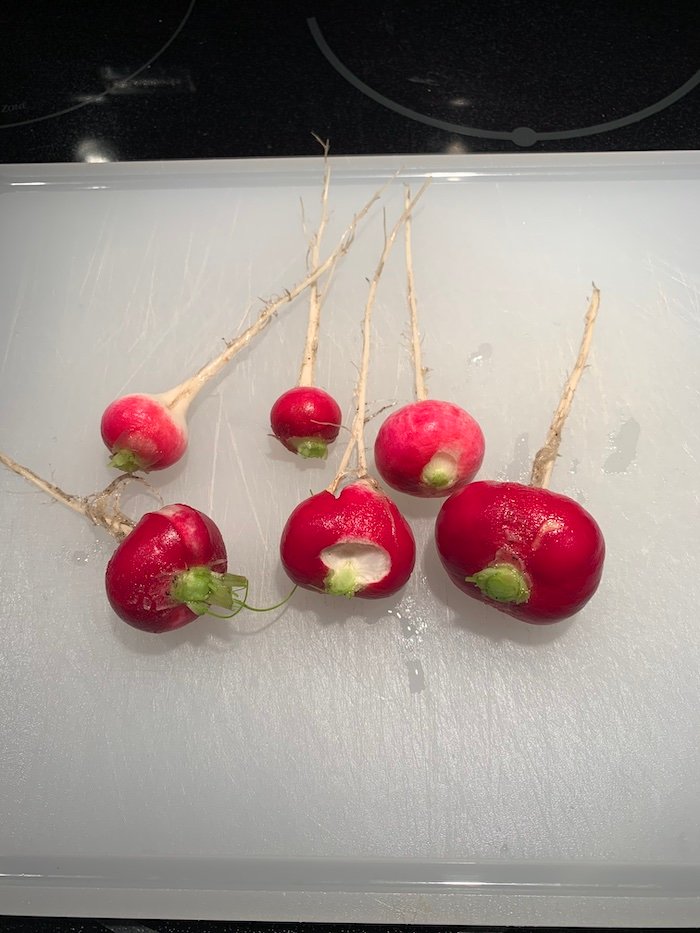
I have a sneaking suspicion that they might be too crowded. I should have made a greater effort to only place one seed per hole. I’ll make sure to remember that when I plant again in the Fall.
Still they are quite delicious.
According to WebMD, radishes are quite healthy:
Radishes are a good source of antioxidants like catechin, pyrogallol, vanillic acid, and other phenolic compounds. These root vegetables also have a good amount of vitamin C, which acts as an antioxidant to protect your cells from damage.
Some health benefits of radishes include:
Reduced Risk for Diabetes
Radishes contain chemical compounds like glucosinolate and isothiocyanate that can help regulate blood sugar levels. Eating radishes also enhances your body’s natural adiponectin production. Higher levels of this hormone can help to protect against insulin resistance. Radishes also contain coenzyme Q10, an antioxidant that helps block the formation of diabetes.
Enhanced Liver Function
Along with other compounds, radishes contain indole-3-carbinol and 4-methylthio-3-butenyl-isothiocyanate, which help the liver detoxify and heal against damage. These same compounds also help the kidneys flush out toxins.
Cardiovascular Improvement
Radishes are rich in antioxidants and minerals like calcium and potassium. Together, these nutrients help lower high blood pressure and reduce your risks for heart disease. The radish is also a good source of natural nitrates that improve blood flow.
Apparently, it’s the same for the daikon (another type of radish).
It might be part of the reason why the Japanese live so long. They eat a lot of daikon.
As for nutrition, radishes are very low in carbs, which makes them a great choice for people monitoring their carbohydrate or sugar intake.
The vegetables have few calories and a low glycemic index level, but they’re rich in these vitamins and minerals:
- Calcium
- Vitamin C
- Riboflavin
- Niacin
- Thiamine
- Vitamin B6
- Folate
- Potassium
- Iron
- Manganese
Conclusion
We’ve had a lot of rain these past few weeks and it might or might not have a negative impact on the garden. I’ve been keeping a journal to write down this kind of information. So, I’ll have a record to refer back to next year.
In terms of this year’s garden, I guess everything is going well so far. I have noticed that my cherry tomatoes and the bell peppers have not really grown much since transplanting them to the garden.
It could be shock or something else. In any case, they are quite tiny. They look healthy though but quite small.
The radishes are the first vegetables I was able to harvest and eat. They may be too crowded and that could lead to low yield. I’m not sure.
In any case, the kids like them and that’s a good sign.
The next report on the state of the garden will likely be in early July.
Stay tuned for that!
In the meantime, feel free to leave a comment and let me know how your own garden is doing so far.
Congratulations @flaglesscanuck! You have completed the following achievement on the Hive blockchain and have been rewarded with new badge(s):
Your next target is to reach 300 upvotes.
You can view your badges on your board and compare yourself to others in the Ranking
If you no longer want to receive notifications, reply to this comment with the word
STOPCheck out the last post from @hivebuzz:
Support the HiveBuzz project. Vote for our proposal!
I took out the first radishes myself yesterday and they were delicious. A bit small, but very yet very hot. And the perfect vegetable to snack on.
I agree; They are a good little snack.
Personally, I knew they were healthy but I didn't know they offered such benefit to human health.